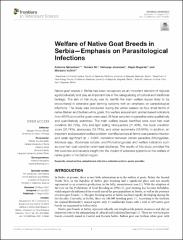Welfare of Native Goat Breeds in Serbia-Emphasis on Parasitological Infections

View/
Date
2021Author
Nenadović, Katarina
Ilić, Tamara
Jovanović, Nemanja
Bugarski, Dejan
Vučinić, Marijana
Metadata
Show full item recordAbstract
Native goat breeds in Serbia has been recognized as an important element of regional
agrobiodiversity and play an important role in the safeguarding of cultural and traditional
heritage. The aim of this study was to identify the main welfare issues likely to be
encountered in extensive goat farming systems with an emphasis on parasitological
infections. The study was conducted during the winter season on four small farms of
native Balkan and Serbian white goats. For welfare assessment, animal-based indicators
from AWIN protocol for goats were used. All fecal samples for parasites were qualitatively
and quantitatively examined. The main welfare issues identified were poor hair coat
condition (62.79%), dirty and light soiling hindquarters (31.40%), thin body condition
score (26.74%), abscesses (19.78%), and udder asymmetry (18.60%). In addition, an
important and prevalent welfare problem identified across all farms was parasite infection
and weak significant (p < 0.001) correlation between certain parasites (Strongylidae,
Moniezia spp., Buxtonella sulcate, and Protostrongylidae) and welfare indicators such
as poor hair coat condition and nasal discharge. The results of this study provided the
first overview and valuable insight into the impact of extensive systems on the welfare of
native goats in the Balcan region.
